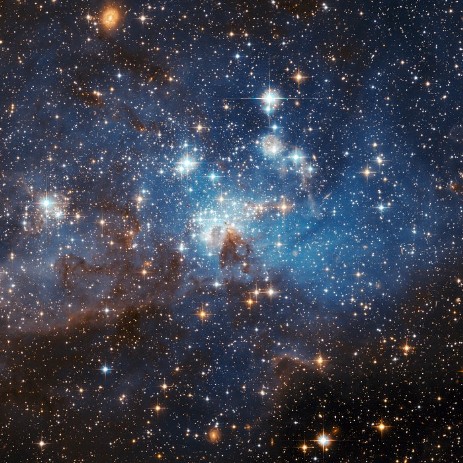Nebulosa Molecolare di Orione
Questa immagine spettacolare della regione di formazione stellare nella Nebulosa di Orione è stata ottenuta con una serie di pose della camera infrarossa HAWK-1 al telescopio VLT dell'ESO in Cile. E' la immagine più profonda di questa regione di cielo finora realizzata e rivela molti più oggetti di massa planetaria di quanto ci si aspettava.
Orion's Molecular Nebula
This spectacular image of the Orion Nebula star-formation region was obtained from multiple exposures using the HAWK-I infrared camera on ESO’s Very Large Telescope in Chile. This is the deepest view ever of this region and reveals more very faint planetary-mass objects than expected.
M42 Nebulosa di Orione
La Nebulosa di Orione è una delle nebulose diffuse più brillanti del cielo notturno. Chiaramente riconoscibile ad occhio nudo come un oggetto di natura non stellare, è posta a sud del famoso asterismo della Cintura di Orione, al centro della cosiddetta Spada di Orione, nell'omonima costellazione. Posta ad una distanza di circa 1.300 a.l. dalla Terra, si estende per circa 24 anni luce ed è la regione di formazione stellare più vicina al Sistema Solare. Per sapere di più...
The Orion Nebula is a diffuse nebula situated in the Milky Way, being south of Orion's Belt in the constellation of Orion. It is one of the brightest nebulae, and is visible to the naked eye in the night sky. M42 is located at a distance of 1,344 ± 20 light years and is the closest region of massive star formation to Earth. The M42 nebula is estimated to be 24 light years across. It has a mass of about 2000 times the mass of the Sun. More info...
Nube molecolare
Una nube molecolare è un tipo di nube interstellare in cui la densità e la temperatura permettono la formazione di idrogeno molecolare (H2) a partire da singoli atomi di idrogeno. Gli addensamenti di idrogeno molecolare rappresentano meno dell'1% del volume del mezzo interstellare di una galassia, pur costituendone la porzione a maggiore densità. Sulla base delle dimensioni vengono suddivise in giganti, piccole (globuli di Bok) e ad alta latitudine. Le nubi molecolari costituiscono il luogo d'elezione per la nascita di nuove stelle. Per saperne di più...
A molecular cloud, sometimes called a stellar nursery (if star formation is occurring within), is a type of interstellar cloud, the density and size of which permit the formation of molecules, most commonly molecular hydrogen (H2). This is in contrast to other areas of the interstellar medium that contain predominantly ionized gas. Within molecular clouds are regions with higher density, where lots of dust and gas cores reside, called clumps. These clumps are the beginning of star formation, if gravity can overcome the high density and force the dust and gas to collapse. More info...
Questa immagine di Hubble Space Telescope, presentata nel 2006 all'Assemblea Generale dell'Unione Astronomica Internazionale a Praga, mostra una grande regione di formazione stellare nella Grande nube di Magellano (LMC). Questa dettagliata immagine rivela come un grande numero di stelle di piccola massa appena nate coesistono con ungrande numero di stelle giovani con massa più massicce. Image Credit: NASA, Hubble, ESA
The latest photo from the Hubble Space Telescope, presented at the 2006 General Assembly of the International Astronomical Union in Prague this week, shows a star forming region in the Large Magellanic Cloud (LMC). This sharp image reveals a large number of low-mass infant stars coexisting with young massive stars. Image Credit: NASA, Hubble, ESA
Sistema Solare Interno Mercurio Venere Terra | Sistema Solare Esterno | Via Lattea | Universo Supernova Extragalattiche |
Prenota la mostra per i tuoi eventi (da novembre 2017) | |||







































